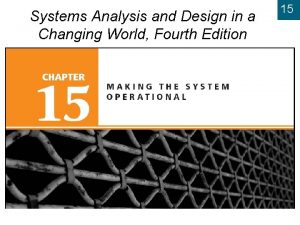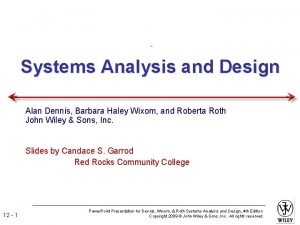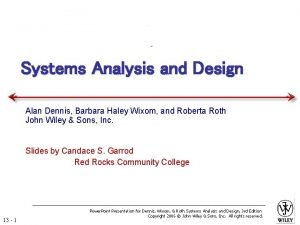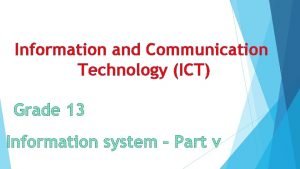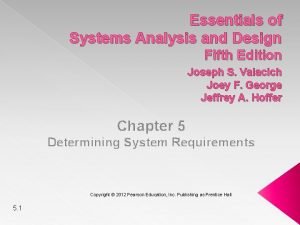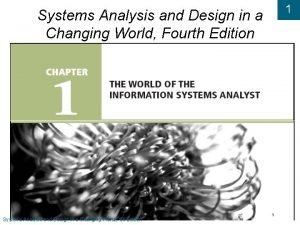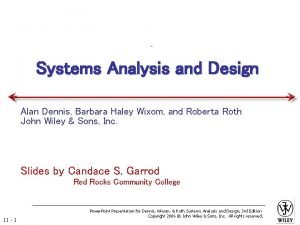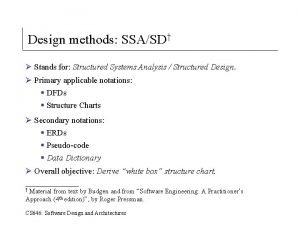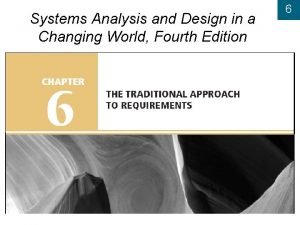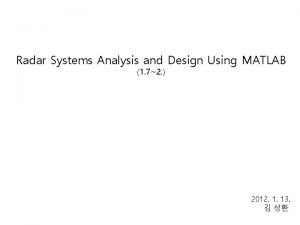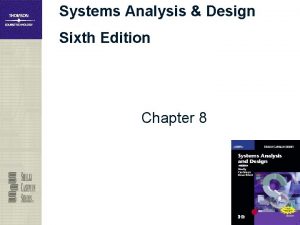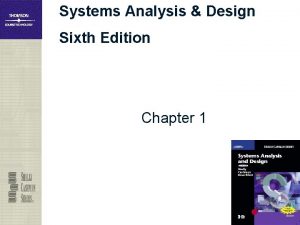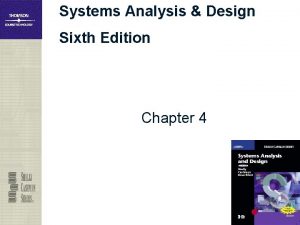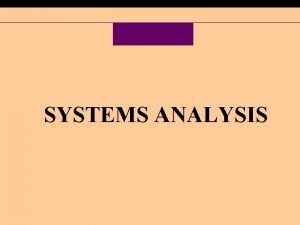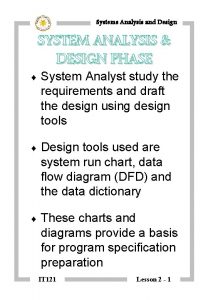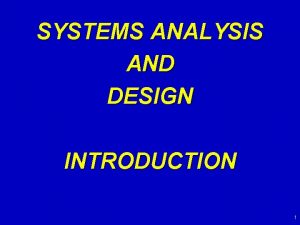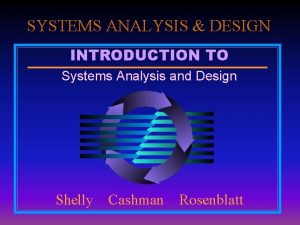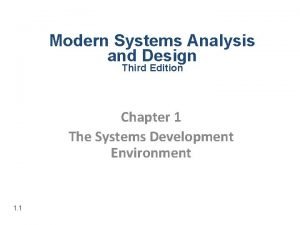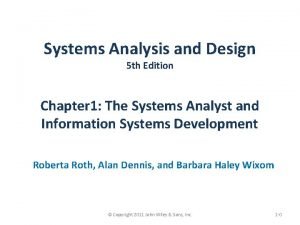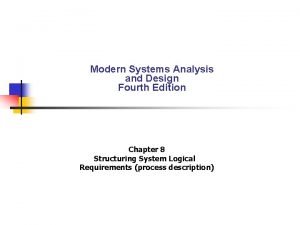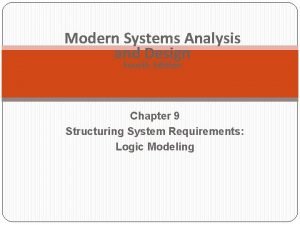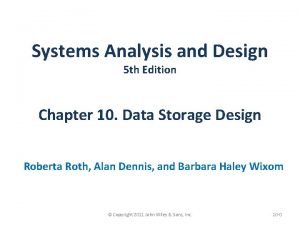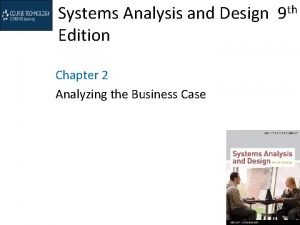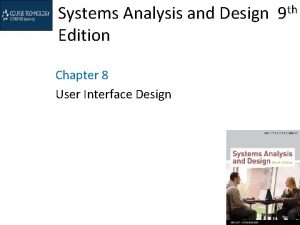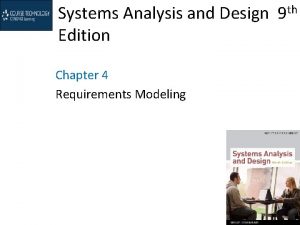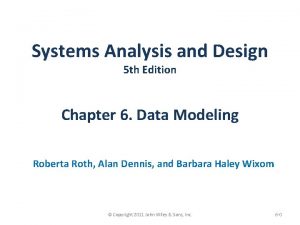Systems Analysis and Design 11 th Edition Chapter







































- Slides: 39

Systems Analysis and Design 11 th Edition Chapter 2 Analyzing the Business Case Copyright © 2017 Cengage Learning. All Rights Reserved. May not be scanned, copied or duplicated, or posted to a publicly accessible website, in whole or in part.

Chapter Objectives � Explain the concept of a business case and how a business case affects an IT project � Describe the strategic planning process and why it is important to the IT team � Explain the purpose of a mission statement � Conduct a SWOT analysis and describe the four factors involved � Explain how the SDLC serves as a framework for systems development Copyright © 2017 Cengage Learning. All Rights Reserved. May not be scanned, copied or duplicated, or posted to a publicly accessible website, in whole or in part. 2

Chapter Objectives (Cont. ) � List reasons for systems projects and factors that affect such projects � Describe systems requests and the role of the systems review committee � Define operational, technical, economic, and schedule feasibility � Explain the factors that affect project priorities � Describe the steps and the end product of a preliminary investigation Copyright © 2017 Cengage Learning. All Rights Reserved. May not be scanned, copied or duplicated, or posted to a publicly accessible website, in whole or in part. 3

Introduction � Business case: Justification for a proposal ◦ Requires consideration of the organization’s: �Overall mission �Objectives �IT needs � Systems development process ◦ Systems request ◦ Preliminary investigation ◦ Findings are submitted to management Copyright © 2017 Cengage Learning. All Rights Reserved. May not be scanned, copied or duplicated, or posted to a publicly accessible website, in whole or in part. 4

A Framework for IT Systems Development � Strategic Planning Overview ◦ Strategic planning: Process of identifying long-term organizational goals, strategies, and resources ◦ Starts with a mission statement �Must reflect the firm’s vision, purpose, and values �Critical success factor: High-priority objective � What Is SWOT Analysis? ◦ Strengths, weaknesses, opportunities, and threats ◦ Examines a firm’s technical, human, and financial resources Copyright © 2017 Cengage Learning. All Rights Reserved. May not be scanned, copied or duplicated, or posted to a publicly accessible website, in whole or in part. 5

A Framework for IT Systems Development (Cont. 1) FIGURE 2 -1 A SWOT analysis might produce results similar to those shown here. Copyright © 2017 Cengage Learning. All Rights Reserved. May not be scanned, copied or duplicated, or posted to a publicly accessible website, in whole or in part. 6

A Framework for IT Systems Development (Cont. 2) FIGURE 2 -2 This SWOT analysis example focuses on a specific asset, such as a company patent. Copyright © 2017 Cengage Learning. All Rights Reserved. May not be scanned, copied or duplicated, or posted to a publicly accessible website, in whole or in part. 7

A Framework for IT Systems Development (Cont. 3) � Strategic Planning for IT Projects ◦ Careful planning can help assure that: �The project supports overall business strategy and operational needs �The project scope is well-defined and clearly stated �The project goals are realistic, and tied to specific statements, assumptions, constraints, factors, and other inputs ◦ Planning tools �Microsoft Word and Excel �CASE tools �Visible Analyst Copyright © 2017 Cengage Learning. All Rights Reserved. May not be scanned, copied or duplicated, or posted to a publicly accessible website, in whole or in part. 8

A Framework for IT Systems Development (Cont. 4) FIGURE 2 -3 The Visible Analyst CASE tool supports strategic planning and allows a user to enter many kinds of planning statements. Notice the four SWOT categories highlighted in the list. Screenshots used with permission from Visible Systems Corporation. Copyright © 2017 Cengage Learning. All Rights Reserved. May not be scanned, copied or duplicated, or posted to a publicly accessible website, in whole or in part. 9

A Framework for IT Systems Development (Cont. 5) � The Changing Role of the IT Department ◦ Management and IT are linked closely �Remarkable changes have occurred in both areas ◦ Today, systems development is much more teamoriented ◦ The IT department is responsible for screening and evaluating systems requests �Larger firms may use an evaluation team or systems review committee Copyright © 2017 Cengage Learning. All Rights Reserved. May not be scanned, copied or duplicated, or posted to a publicly accessible website, in whole or in part. 10

What Is a Business Case? �A business case should: ◦ Be comprehensive and easy to understand ◦ Describe the project clearly, provide the justification to proceed, and estimate the project’s financial impact � Questions ◦ ◦ ◦ answered by a business case Why are we doing this project? How much will it cost and how long will it take? Are there any risks involved? How will we measure success? What alternatives exist? Copyright © 2017 Cengage Learning. All Rights Reserved. May not be scanned, copied or duplicated, or posted to a publicly accessible website, in whole or in part. 11

Information Systems Projects FIGURE 2 -4 Six main reasons for systems requests. Copyright © 2017 Cengage Learning. All Rights Reserved. May not be scanned, copied or duplicated, or posted to a publicly accessible website, in whole or in part. 12

Information Systems Projects (Cont. ) FIGURE 2 -6 Internal and external factors that affect IT projects. Copyright © 2017 Cengage Learning. All Rights Reserved. May not be scanned, copied or duplicated, or posted to a publicly accessible website, in whole or in part. 13

Evaluation of Systems Requirements � Systems requests are evaluated by a systems review committee or a computer resources committee � Systems Request Forms ◦ ◦ ◦ Streamline the request process Ensure consistency Easy to understand Include clear instructions Indicate the required supporting documents Submitted electronically Copyright © 2017 Cengage Learning. All Rights Reserved. May not be scanned, copied or duplicated, or posted to a publicly accessible website, in whole or in part. 14

Evaluation of Systems Requirements (Cont. 1) FIGURE 2 -10 Example of an online systems request form. Source: Florida Institute of Technology Copyright © 2017 Cengage Learning. All Rights Reserved. May not be scanned, copied or duplicated, or posted to a publicly accessible website, in whole or in part. 15

Evaluation of Systems Requirements (Cont. 2) � Systems Review Committee ◦ A broader viewpoint enables a committee to establish priorities more effectively than an individual �One person’s bias is less likely to affect decisions ◦ Disadvantages �Action on requests must wait until the committee meets �Members might favor projects requested by their own departments �Internal political differences could delay important decisions Copyright © 2017 Cengage Learning. All Rights Reserved. May not be scanned, copied or duplicated, or posted to a publicly accessible website, in whole or in part. 16

Overview of Feasibility � Feasibility studies can be simple or exhaustive � Effort required depends on the nature of the request � Initial fact-finding involves: ◦ ◦ ◦ Studying organizational charts Performing interviews Reviewing current documentation Observing operations Surveying users Copyright © 2017 Cengage Learning. All Rights Reserved. May not be scanned, copied or duplicated, or posted to a publicly accessible website, in whole or in part. 17

Overview of Feasibility (Cont. 1) FIGURE 2 -11 A feasibility study examines operational, technical, economic, and schedule factors. Copyright © 2017 Cengage Learning. All Rights Reserved. May not be scanned, copied or duplicated, or posted to a publicly accessible website, in whole or in part. 18

Overview of Feasibility � Operational (Cont. 2) Feasibility ◦ A proposed system will be used effectively after it has been developed ◦ Can be affected by organizational culture ◦ Cannot be accurately measured but requires careful study ◦ Questions that can help predict a system’s operational feasibility �Is the project supported by management and users? �Will the new system result in a workforce reduction? �Do legal or ethical issues need to be considered? Copyright © 2017 Cengage Learning. All Rights Reserved. May not be scanned, copied or duplicated, or posted to a publicly accessible website, in whole or in part. 19

Overview of Feasibility � Economic (Cont. 3) Feasibility ◦ Projected benefits of a proposed system out-weigh total cost of ownership (TCO) ◦ Determination of TCO requires cost analysis of: �People, including IT staff and users �Hardware and equipment �Software �Formal and informal training �Licenses and fees �Consulting expenses �Facility costs Copyright © 2017 Cengage Learning. All Rights Reserved. May not be scanned, copied or duplicated, or posted to a publicly accessible website, in whole or in part. 20

Overview of Feasibility (Cont. 4) ◦ Tangible costs are measured in dollars ◦ Intangible costs can significantly affect organizational performance ◦ Tangible benefits can result from a decrease in expenses or an increase in revenues ◦ Intangible benefits are important to the company despite the inability to measure them in dollars Copyright © 2017 Cengage Learning. All Rights Reserved. May not be scanned, copied or duplicated, or posted to a publicly accessible website, in whole or in part. 21

Overview of Feasibility � Technical (Cont. 5) Feasibility ◦ Technical resources required to acquire and use the system ◦ Questions analysts should ask �Does the company have the necessary hardware, software, and network resources? �Does the company have the required technical expertise? �Does the proposed platform have sufficient capacity for future needs? �Will a prototype be required? Copyright © 2017 Cengage Learning. All Rights Reserved. May not be scanned, copied or duplicated, or posted to a publicly accessible website, in whole or in part. 22

Overview of Feasibility � Schedule (Cont. 6) Feasibility ◦ A project can be implemented in an acceptable time frame ◦ Issues that can affect schedule feasibility �Interaction between time and costs �Can the company or the IT team control the factors that affect schedule feasibility? �Has management established a firm timetable for the project? �What conditions must be satisfied during the development of the system? �Will an accelerated schedule pose any risks? Copyright © 2017 Cengage Learning. All Rights Reserved. May not be scanned, copied or duplicated, or posted to a publicly accessible website, in whole or in part. 23

Evaluating Feasibility � Identify and weed out systems requests that are not feasible ◦ Some feasible requests may not be necessary � Requests that are not currently feasible can be resubmitted as new hardware, software, or expertise becomes available Copyright © 2017 Cengage Learning. All Rights Reserved. May not be scanned, copied or duplicated, or posted to a publicly accessible website, in whole or in part. 24

Setting Priorities � Factors that Affect Priority ◦ Will the proposed system reduce costs? ◦ Will the system increase revenue for the company? ◦ Will the systems project result in more information or produce better results? ◦ Will the system serve customers better? ◦ Will the system serve the organization better? ◦ Can the project be implemented in a reasonable time period? ◦ Are the necessary financial, human, and technical resources available? Copyright © 2017 Cengage Learning. All Rights Reserved. May not be scanned, copied or duplicated, or posted to a publicly accessible website, in whole or in part. 25

Setting Priorities � Discretionary (Cont. ) and Nondiscretionary Projects ◦ Discretionary projects: Projects where management has a choice in implementing them ◦ Nondiscretionary projects: Management has no choice in implementing a project �Most of these projects are predictable �Annual updates to payroll �Tax percentages �Quarterly changes Copyright © 2017 Cengage Learning. All Rights Reserved. May not be scanned, copied or duplicated, or posted to a publicly accessible website, in whole or in part. 26

Preliminary Investigation Overview � Interaction with Managers and Users ◦ Meet with key managers, users, and IT staff to describe the project, explain responsibilities, answer questions, and invite comments ◦ Focus on improvements and enhancements, not problems Copyright © 2017 Cengage Learning. All Rights Reserved. May not be scanned, copied or duplicated, or posted to a publicly accessible website, in whole or in part. 27

Preliminary Investigation Overview (Cont. 1) FIGURE 2 -12 Model of a preliminary investigation. Notice the importance of factfinding in each of the four areas. FIGURE 2 -13 Six main steps in a typical preliminary investigation. Copyright © 2017 Cengage Learning. All Rights Reserved. May not be scanned, copied or duplicated, or posted to a publicly accessible website, in whole or in part. 28

Preliminary Investigation Overview (Cont. 2) � Planning the Preliminary Investigation ◦ Step 1 - Understand the problem or opportunity �Develop a business profile that describes current business processes and functions �Understand how modifications will affect business operations and other information systems �Identify the departments, users, and business processes involved �Consider using a fishbone diagram Copyright © 2017 Cengage Learning. All Rights Reserved. May not be scanned, copied or duplicated, or posted to a publicly accessible website, in whole or in part. 29

Preliminary Investigation Overview (Cont. 3) FIGURE 2 -14 A fishbone diagram displays the causes of a problem. Typically, you must dig deeper to identify actual causes rather than just symptoms. Copyright © 2017 Cengage Learning. All Rights Reserved. May not be scanned, copied or duplicated, or posted to a publicly accessible website, in whole or in part. 30

Preliminary Investigation Overview (Cont. 4) � Planning the Preliminary Investigation (Cont. ) ◦ Step 2 - Define the project scope and constraints �Define the specific boundaries, or extent, of the project �Define project scope by creating a list with sections called must do, should do, could do, and won’t do �Avoid project creep �Project creep: Process by which projects with very general scope definitions expand gradually, without specific authorization �Identify constraints �Constraint: A requirement or condition that the system must satisfy or an outcome that the system must achieve Copyright © 2017 Cengage Learning. All Rights Reserved. May not be scanned, copied or duplicated, or posted to a publicly accessible website, in whole or in part. 31

Preliminary Investigation Overview (Cont. 5) FIGURE 2 -15 Examples of various types of constraints. Copyright © 2017 Cengage Learning. All Rights Reserved. May not be scanned, copied or duplicated, or posted to a publicly accessible website, in whole or in part. 32

Preliminary Investigation Overview (Cont. 6) � Planning the Preliminary Investigation (Cont. ) ◦ Step 3 - Perform fact-finding �Gather data about project usability, costs, benefits, and schedules �Analyze organization charts, conduct interviews, review documentation, observe operations, and conduct a user survey �Analyze the data �Pareto chart �XY chart (scatter diagram) Copyright © 2017 Cengage Learning. All Rights Reserved. May not be scanned, copied or duplicated, or posted to a publicly accessible website, in whole or in part. 33

Preliminary Investigation Overview (Cont. 7) FIGURE 2 -17 A Pareto chart displays the causes of a problem, in priority order, so an analyst can tackle the most important causes first. In this example, the part number issue would be the obvious starting point. FIGURE 2 -18 An XY chart shows correlation between variables, which is very important in problem solving. Conversely, a lack of correlation suggests that the variables are independent, and that you should look elsewhere for the cause. Copyright © 2017 Cengage Learning. All Rights Reserved. May not be scanned, copied or duplicated, or posted to a publicly accessible website, in whole or in part. 34

Preliminary Investigation Overview (Cont. 8) � Planning the Preliminary Investigation (Cont. ) ◦ Step 4 - Analyze project usability, cost, benefit, and schedule data �Factors to consider �What information must be obtained, and how will it be gathered analyzed? �Who will conduct the interviews? How many people will be interviewed? �Will a survey be conducted? Who will be involved? How much time will it take to tabulate the results? �How much will it cost to analyze the information and prepare a report with findings and recommendations? Copyright © 2017 Cengage Learning. All Rights Reserved. May not be scanned, copied or duplicated, or posted to a publicly accessible website, in whole or in part. 35

Preliminary Investigation Overview (Cont. 9) � Planning the Preliminary Investigation (Cont. ) ◦ Step 5 - Evaluate feasibility �Operational feasibility �Technical feasibility �Economic feasibility �Schedule feasibility ◦ Step 6 - Present results and recommendations to management �Prepare a report that includes: �An evaluation of the systems request �An estimate of costs and benefits �A case for action Copyright © 2017 Cengage Learning. All Rights Reserved. May not be scanned, copied or duplicated, or posted to a publicly accessible website, in whole or in part. 36

Preliminary Investigation Overview (Cont. 10) � Planning the Preliminary Investigation (Cont. ) �Format of a report �Introduction �Systems request summary �Findings �Recommendations �Project roles �Time and costs estimates �Expected benefits �Appendix Copyright © 2017 Cengage Learning. All Rights Reserved. May not be scanned, copied or duplicated, or posted to a publicly accessible website, in whole or in part. 37

Chapter Summary � Systems planning is the first phase of the systems development life cycle � A business case should: ◦ Describe the project clearly ◦ Provide the justification to proceed ◦ Estimate the project’s financial impact � Factors that affect systems projects ◦ User requests, top management directives, existing systems, the IT department, software and hardware vendors, technology, customers, competitors, the economy, and government Copyright © 2017 Cengage Learning. All Rights Reserved. May not be scanned, copied or duplicated, or posted to a publicly accessible website, in whole or in part. 38

Chapter Summary (Cont. ) � Analysts evaluate the systems request and determine whether the project is feasible from an operational, technical, economic, and schedule standpoint � Steps in the preliminary investigation ◦ Understand the problem or opportunity ◦ Define the project scope and constraints ◦ Perform fact-finding and analyze project usability, cost, benefit, and schedule data ◦ Evaluate feasibility and present results and recommendations to management Copyright © 2017 Cengage Learning. All Rights Reserved. May not be scanned, copied or duplicated, or posted to a publicly accessible website, in whole or in part. 39
 A modern approach to systems analysis and design
A modern approach to systems analysis and design Modern systems analysis and design 7th edition
Modern systems analysis and design 7th edition Phases of system analysis and design
Phases of system analysis and design Mis chapter 6
Mis chapter 6 Using mis (10th edition) 10th edition
Using mis (10th edition) 10th edition Systems analysis & design in an age of options
Systems analysis & design in an age of options Gantt chart system analysis and design
Gantt chart system analysis and design Systems analysis and design in a changing world
Systems analysis and design in a changing world Systems analysis and design in a changing world
Systems analysis and design in a changing world Systems analysis and design alan dennis
Systems analysis and design alan dennis Introduction to systems analysis and design
Introduction to systems analysis and design Structured system analysis and design methodology
Structured system analysis and design methodology Modern systems analysis and design
Modern systems analysis and design Kendall & kendall systems analysis and design
Kendall & kendall systems analysis and design Systems analysis and design alan dennis
Systems analysis and design alan dennis Systems analysis and design alan dennis
Systems analysis and design alan dennis Systems analysis and design alan dennis
Systems analysis and design alan dennis Systems analysis and design alan dennis
Systems analysis and design alan dennis Systems analysis and design alan dennis
Systems analysis and design alan dennis Systems analysis and design alan dennis
Systems analysis and design alan dennis Systems analysis and design alan dennis
Systems analysis and design alan dennis Ssadm diagram
Ssadm diagram Radar systems analysis and design using matlab
Radar systems analysis and design using matlab Object-oriented systems analysis and design using uml
Object-oriented systems analysis and design using uml A modern approach to systems analysis and design
A modern approach to systems analysis and design Patched up prototype
Patched up prototype Systems analysis and design in a changing world
Systems analysis and design in a changing world Systems analysis and design in a changing world
Systems analysis and design in a changing world Systems analysis and design in a changing world
Systems analysis and design in a changing world Systems analysis and design alan dennis
Systems analysis and design alan dennis Systems analysis and design alan dennis
Systems analysis and design alan dennis Systems analysis and design alan dennis
Systems analysis and design alan dennis Structured system of communication
Structured system of communication Essentials of systems analysis and design
Essentials of systems analysis and design Systems analysis and design in a changing world
Systems analysis and design in a changing world Systems analysis and design alan dennis
Systems analysis and design alan dennis Ssasd
Ssasd Systems analysis and design in a changing world
Systems analysis and design in a changing world Systems analysis and design in a changing world
Systems analysis and design in a changing world Radar system analysis and design using matlab
Radar system analysis and design using matlab


























